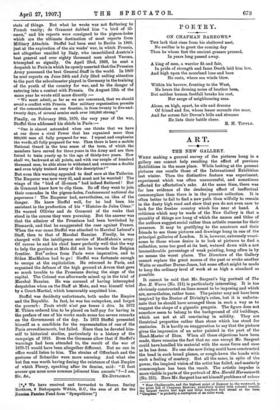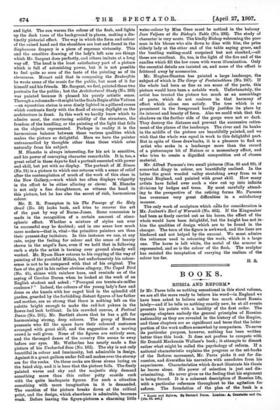ART.
THE NEW GALLERY.
WHEN making a general survey of the pictures hung in a gallery one cannot help recalling the effect of previous Exhibitions in the same place. While looking at the present pictures one recalls those of the International Exhibition last winter. Then the distinctive feature was experiment, experiment which was often unsuccessful, and sometimes affected for affectation's sake. At the same time, there was far less evidence of the deadening effect of ineffectual commonplace than there is in the present collection. It is often better to fail to find a new path than wilfully to remain in the dusty high road and show that you do not even care to look for the fresher country which lies near at hand. A criticism which may be made of the New Gallery is that a quantity of things are hung of which the names and titles of the authors suggest social rather than artistic reasons for their presence. It may be gratifying to the amateurs and their friends to see these pictures and drawings hung in one of the principal galleries of London. It is, however, extremely weari- some to those whose desire is to look at pictures to find a collection, none too good at its best, watered down with a not inconsiderable percentage of weak painting, hung often in by no means the worst places. The Director° of the Gallery cannot replace the great names of the past or evoke another Watts or another Bume-Jones, but some effort might be made to keep the ordinary level of work at as high a standard as possible.
It cannot be said that Mr. Sargent's big portrait of The Rev. E. Wane (No. 211) is particularly interesting. It is too obviously constructed on lines meant to be imposing and which are, nevertheless, rather tame. The painter may not have been inspired by the Doctor of Divinity's robes, but it is unforta• nate that he should have arranged them in such a way as to suggest the shape of a gigantic penguin. The figure does not somehow seem to belong to the background of old buildings, which are not at all convincing in solidity. They are theatrical properties rather than stone which has stood for centuries. It is hardly an exaggeration to say that the picture gives the impression of an actor painted in the part of the Head-Master of Eton. When all these objections have been made, there remains the fact that no one except Mr. Sargent could have handled his material with the same force and ease as he has done. No one else now living could have constructed the bead in such broad planes, or rough-hewn the hands with such a feeling of mastery. But all the same, in spite of the power, the inspired vision of the artist has failed, and masterly commonplace has been the result. The artistic impulse is more visible in parts of the portrait of Mrs. Harold Harmsioarth (No. 218). Here Mr. Sargent has set himself problems of colour • Near Challacombe, and the highest point_ _of Eraserto.the westward. is tte. =tstall.woefl,Chrger EigEhararsibletnrulizeddo feet' 'with colossal Chapman " is proebsbIy a corruption ot an 'Order word. and light. The sun warms the colour of the flesh, and lights up the dark trees of the background in places, making a dis- tinctly pictorial effect. The way in which the form and colour of the raised hand and the shoulders are lost and found in the diaphanous drapery is a piece of supreme virtuosity. This and the sensitive drawing of the lady's left arm are things which Mr. Sargent does perfectly, and others imitate at a long way off. The head is the least satisfactory part of a picture which is full of astonishing power, but it is not possible to feel quite so sure of the taste of the painting as of its cleverness. Mozart said that in composing the Zauberfhite he wrote some of the music for the public, but most of it for himself and his friends. Mr. Sargent, we feel, painted these two portraits for the public ; but the Architectural Study (No.268) was painted because it pleased his purely artistic sense. Through a colonnade—it might be the Scala Regia of the Vatican —an equestrian statue is seen dimly lighted in a pillared recess which contrasts finely with the flood of strong daylight on the architecture in front. In this work we hardly know which to admire most, the convincing solidity of the structure, the freedom of the handling, or the painting of the light that falls on the objects represented. Perhaps in reality it is the harmonious balance between these various qualities which makes the picture so delightful. Here we have the painter untrammelled by thoughts other than those which arise naturally from his subject.
M. Blanche is always interesting, for hill art is sensitive, and his power of conveying character remarkable. It is, too, a great relief in these days to find a portrait executed with power and skill, but yet with no display. The portrait of M. Simon (No. 91) is a picture to which one returns with a sense of relief after the contemplation of much of the work of this class in the New Gallery,—work which too often displays vulgarity in the effort to be either alluring or clever. X. Blanche is not only a fine draughtsman, as witness the hand in this picture, but he has also the secret of rich, harmonious colour.
Mr. E. R. Frampton in his The Passage of the Holy Grail (No. 58) looks back, and tries to recover the art of the past by way of Borne-Jones. Some concession is made in the recognition of a certain amount of atmo- spheric effect. Whether a mixture of styles can ever be successful may be doubted ; and in one sense bow much more modern—that is, vital—the primitive painters are than their present-day imitators. In this instance we can, at any rate, enjoy the feeling for colour and the sense of beauty shown in the angel's face, even if we hold that in following such a style the artist is turning over ground already well worked. Mr. Byam Shaw returns to his copying of the way of painting of the youthful Millais, but unfortunately his colour- sense is not to be compared with that of his original. The face of the girl in his rather obvious allegory, The Caged Bird (No. 45), shines with rainbow hues, and reminds us of the saying of Carole Duran when he looked at the work of an English student and asked "Ponrquoi ces trente-six-milles conleurs ? " Indeed, the colours of the young lady's face and dress as she kneels with her caged bird in the splendid old garden, guarded by the forbidding distant figures of her father and mother, are so strong that there is nothing left on the palette bright enough to make the red-hot pokers in the flower-bed look brilliant. In his crowded canvas, A Festival Dance (No. 201), Mr. Bartlett shows that he has a gift for harmonising 'strong, deep colours. The group of Breton peasants who fill the space have their coloured costumes arranged with great skill, and the suggestion of a moving crowd is well given. None of the figures are entirely seen, and the thronged dance of the country fête seems to sway before our eyes. Mr. Wetherbee has nearly made a fine picture of his Uncharted Seas (No. 182). The sky is not only beautiful in colour and luminosity, but admirable in design. Against it a great galleon under full sail makes over the stormy sea for the rocks. On these rocks are three sirens luring on the fated ship, and it is here that the pioture fails. The finely painted waves and sky and the majestic ship demand something more than this rather petty seaside rock with the quite inadequate figures. For such a situation something with more imagination in it is demanded. The emotion of the picture breaks down at the critical point, and the design, which elsewhere is admirable, becomes weak. Before leaving the figure-pictures a charming little
water-colour by Miss Gere must be noticed in the balcony Jean Vatican at the Bishop's Table (No. 292). The stady of character is very acute. The kindly Bishop welcoming the poor man in his blouse who sits down to dine with him, the prim elderly lady at the other end of the table saying grace, and the bustling waiting-maid surprised but not shocked,—all these are excellent. So, too, is the light of the fire and of the candles which fill the low room with warm illumination. Only the essential details are insisted on, and none of the effect is frittered away by accessories.
Mr. Hughes-Stanton has painted a large landscape, the
subject of which is The Gorge of Fontainebleau (No. 247). If the whole had been as fine as are some of the parts, this picture would have been a notable work. Unfortunately, the artist has treated the picture too much as an assemblage of parts, which do not coalesce in that harmony of effect which alone can satisfy. The tree which is so prominent in the foreground hardly justifies its place by its interest and beauty of form. Also we could wish that the shadows on the further side of the gorge were not so dark. They destroy the distance and prevent the successive retire- ment of the planes of the landscape. The river and its banks in the middle of the picture are beautifully painted, and we wish that the whole was equal in work to this delightful part. But in spite of these drawbacks, it is a pleasure to find an
artist who seeks in a landscape more than the record of a picturesque bit of Nature or a momentary effect, and who tries to create a dignified composition out of chosen material.
Mr. Alfred Parsons's two small pictures (Nos. 85 and 89), if somewhat dingy in colour, are beautifully realised. In the latter the great wooded valley stretching away from us is typical England, and painted with great skill. How many artists have failed over such a view cut up into infinite divisions by hedges and trees. By most carefully attend- ing to the perspective of the retiring forms Mr. Parsons has overcome very great difficulties in a satisfactory manner.
The only work of sculpture which mills for consideration is
Mr. Joubert's Earl of Warwick (No. 482). If the Kingmaker had been as finely carried out as his horse, the effect of the whole would have been delightful, but the knight has not in- him the qualities of design which are to be found in the charger. The tarn of the figure is awkward, and the lines are hindered and not helped by the aurcoat. We must admire the reticence used in colouring the work, which is a large one. The horse is left white, the metal of the armour is represented, and so is the colour of the flesh. The sculptor has resisted the temptation of carrying the realism of the colour too far.
H. S.



























































 Previous page
Previous page